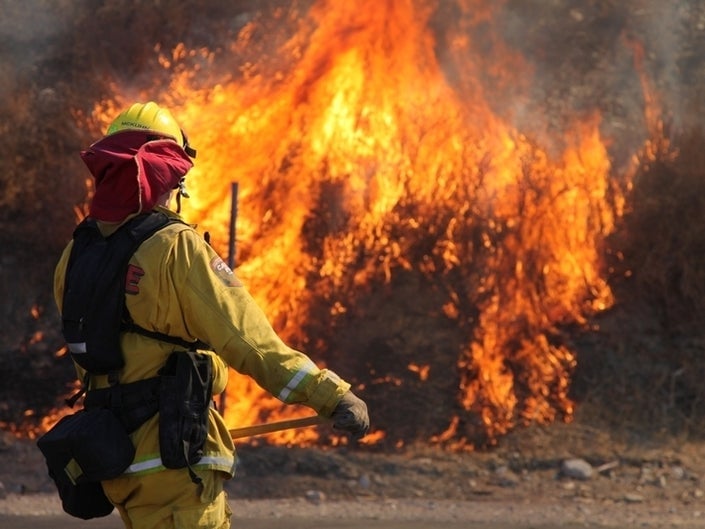As the 2020 fire season approaches, aerial firefighters are instituting more protective measures for their flight crews and mechanics who may be at higher risk of contracting the coronavirus during a wildland fire operation.
“We are in unchartered territory,” said Robin Rogers, Vice-President of Rogers Helicopters in Fresno, California, “although we are following all the Center For Disease Control and Prevention guidelines.”
Rogers noted that, to date, the US Forest Service has not issued guidelines for COVID-19 protection specifically oriented to aerial firefighters. “If the COVID-19 risk extends into the fire season, hopefully, there will be procedures in place that will afford protection for all the firefighters, including our flight crews and mechanics in the field.”
Rogers Helicopters has two Bell 212s under exclusive use, and two Bell 212s under call when needed contracts with the US Forest Service. All are used for water drops, as well as personnel transport. Two additional fixed-wing Turbine Commanders are used for traffic control.
Other aerial firefighting operators have expressed similar concerns, and are taking aggressive measures to protect their employees during a fire event.
“We are taking precautions in the field, based on the standard guidelines issued by the CDCP to address the spread of COVID-19,” said Rick Livingston, President of Intermountain Helicopter in Sonora, California. That, he explained, includes sanitizing the company’s single Bell 212 helicopter by “applying any alcohol-based cleaners to any surface people are likely to come in contact with.”
“We stocked up on a large quantity of hand sanitizers prior to when the pandemic gathered momentum in the US,” he noted.
Intermountain Helicopter, said Livingston, deploys the helicopter with one pilot, one mechanic, a fuel truck driver and occasionally a mechanic’s helper. “Since we are a small operation, it’s really just a matter of doing a lot of self-monitoring, and monitoring each other,” he remarked. “If anyone shows up with any of the symptoms associated with the coronavirus, I will not allow that person to fly.”
Josh Beckham, General Manager of Helimax Aviation, reported that the McClellan, California-based company is encouraging all of its employees to exercise precautionary practices—including social distancing and the use of masks. At the same time, the company is limiting its workforce in the field, as well as at its headquarters, to essential employees only.
Currently, the operator has four CH-47D Chinook helicopters available for firefighting, with one under a US Forest Service exclusive use contract. Each helicopter is deployed with two pilots, five mechanics and a fuel truck driver.
In addition to masks, Helimax Aviation is providing cleaning products, such as hand sanitizers and bleach wipes, to its crews in the field, Beckham pointed out. “Aircraft are now cleaned after every crew rotation, which takes place every 12 days. However, our crews have also been told to give the aircraft a cleaning sooner, if necessary,” he said. “This includes cleaning any surface subjected to touch—primarily the controls.”
Procurement of cleaning products, said Beckham, has become more challenging in recent weeks. “Normally, we procure them on the retail market, and so far, we’ve been able to get an adequate supply,” he noted. “But now it takes more effort to find them.”
Missoula, Montana-based fixed-wing tanker operator Neptune Aviation Services has developed its own guidance document for procedures and protocols, specifically addressing the COVID-19 risk. Many of the guidelines used for the protocol were incorporated from those published by the Center for Disease Control and Prevention, Dan Snyder, the company’s Chief Operating Officer explained.
“Our document also includes guidance from the FAA as well as BAE Systems, the aircraft manufacturer,” he said. “Along with travel, and lodging, it also focuses on workplace interaction among crews, as well as with those at tanker bases.” Tanker bases, Snyder noted, are areas of higher risk, given the concentration of people.
“From BAE Systems, we incorporated their suggested methods of cleaning any surfaces likely to be touched, without risking damage to the aircraft,” said Snyder. “That includes a normal standard, as well as an enhanced, cleaning process, which would be used in case someone on or around the aircraft becomes ill. Our flight crews and mechanics have been trained to do both, using the appropriate cleaning products and quantities.”
Currently, Neptune Aviation Services has nine BAe 146 regional airliners, modified for aerial firefighting, of which four are under USFS exclusive use contracts, with the others available, if needed.
“The aerial firefighting operators will continue to take all necessary measures to assure that protective protocols are followed for as long as COVID-19 remains a threat,” said George Hill, Executive Director of the American Helicopter Services and Aerial Firefighting Association (AHSAFA). “As the pandemic runs its course, the industry will assure the firefighting community that it will minimize any risks of contracting the illness from its flight crews and mechanics at tanker and helicopter bases, while remaining mission ready at the highest levels.”
Helimax Aviation, Intermountain Helicopter, Neptune Aviation Services, and Rogers Helicopters are members of AHSAFA, the Washington-based trade association representing the privately operated aerial firefighting industry before the US Forest Service and other agencies tasked with federal wildland management and fire protection.






